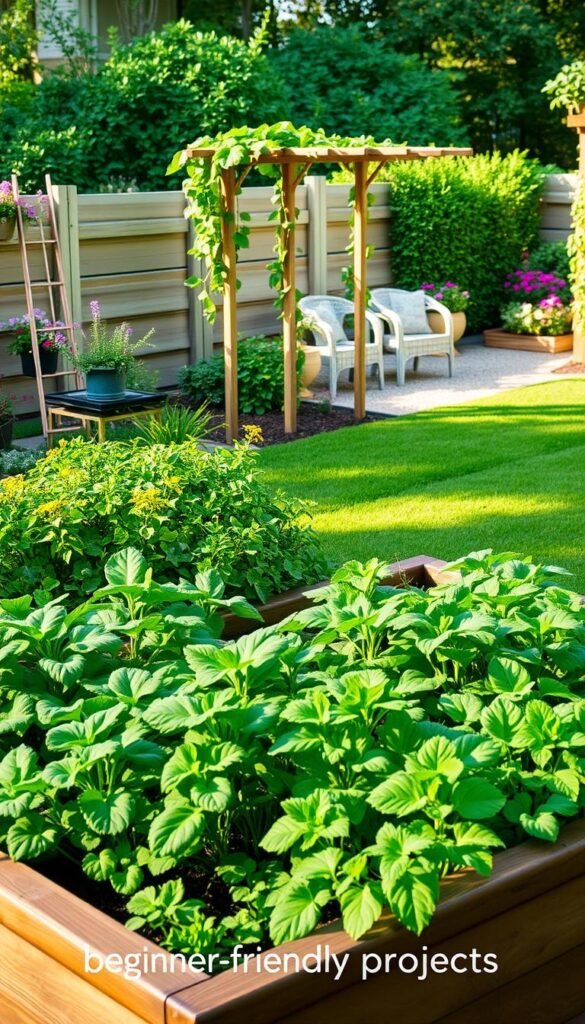Welcome to the joyful journey of cultivating your own green oasis! Whether you have a sprawling backyard or a cozy balcony, creating a vibrant outdoor space is within reach. This guide focuses on low-effort, high-reward concepts designed to help you grow your skills while watching your efforts blossom.
Every project here prioritizes simplicity and visual appeal. You’ll discover how small touches like aromatic herbs in containers or colorful flower borders can make a big difference. These selections build confidence by offering quick wins, letting you see progress without complex tools or expertise.
Why start small? Early successes keep motivation high and lay the foundation for future ventures. You’ll learn practical techniques—like preparing soil or arranging plants—that apply to larger endeavors. Plus, many options work for renters and homeowners alike, adapting to any space or lifestyle.
From pollinator-friendly additions to decorative accents, each idea balances beauty and functionality. We’ve included budget-conscious tips and clear instructions to remove guesswork. Grab your gloves—it’s time to dig into a hobby that grows with you!
Kickstart Your Garden Journey with Essential Planning and Tools
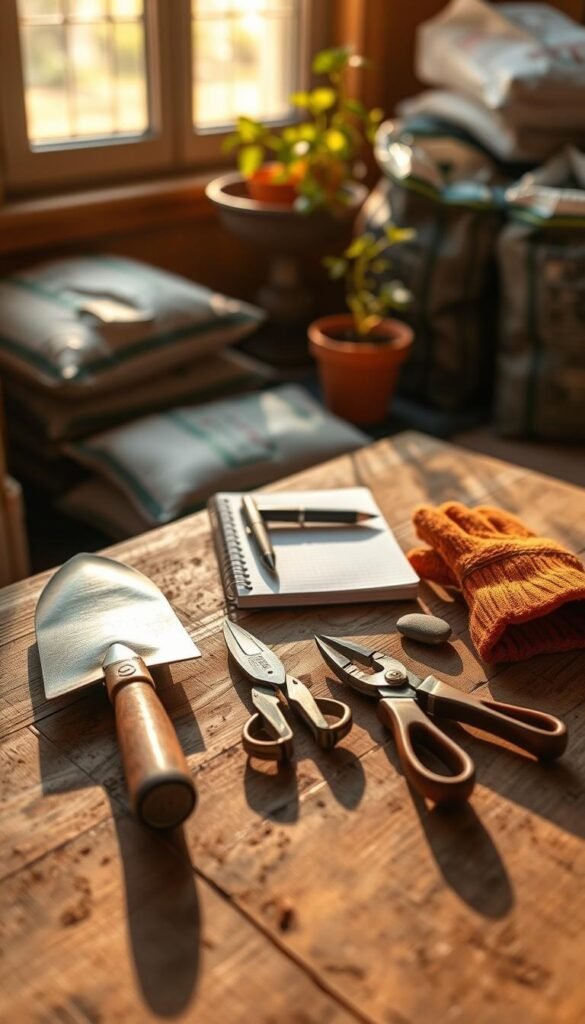
Laying the foundation for a thriving garden starts with thoughtful preparation. Begin by observing your yard or balcony to identify sunny spots—most edible plants need six hours of direct sunlight daily. Track how shadows move across your space to pinpoint the best planting areas.
| Tool | Purpose | Budget Tip |
|---|---|---|
| Hand Trowel | Planting small herbs | Check thrift stores |
| Pruning Shears | Trimming plants | Share with neighbors |
| Watering Can | Gentle hydration | Repurpose containers |
Test your soil’s texture and drainage before planting. Sandy soils dry quickly, while clay holds moisture longer. If ground conditions aren’t ideal, consider raised beds—they offer better control over soil quality. Follow these steps to design your layout:
- Measure available space
- Sketch plant locations
- Group plants by sunlight needs
Start with a 4×4 foot area to avoid overwhelm. This budget-conscious approach lets you refine techniques before expanding. Remember, even windowsill gardens count as victories!
Designing Your Own Herb Garden and DIY Planter Project
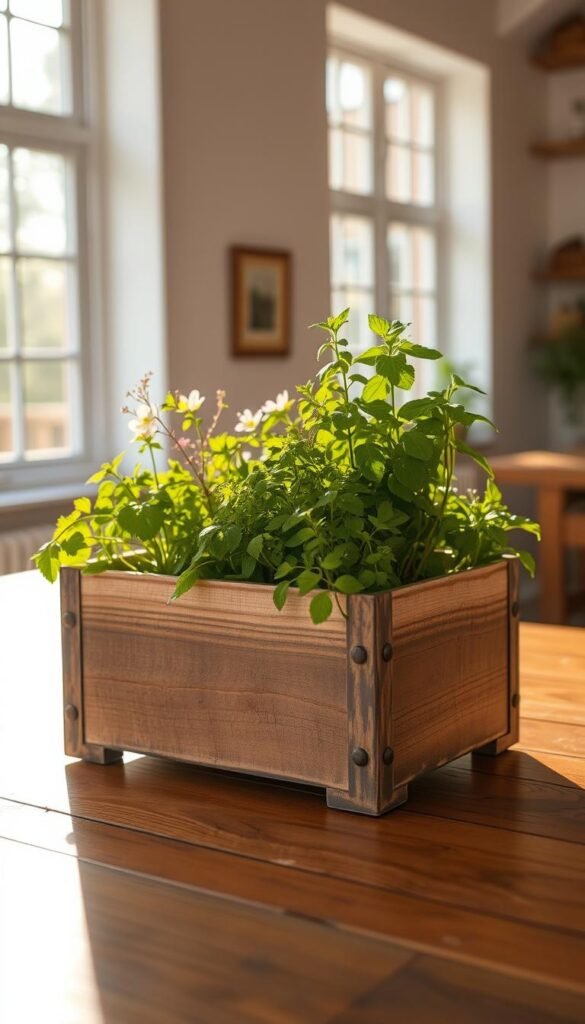
Imagine snipping fresh herbs for dinner while snow falls outside your window. With a mobile planter setup, you can enjoy vibrant flavors year-round. Inspired by gardening duo Alice & Louis, this approach lets you move plants between patio and windowsill effortlessly.
Create an Herb Garden Planter for Year-Round Freshness
Start with fast-growing varieties like basil and parsley—perfect for new growers. Chives and mint thrive in containers, needing just sunlight and weekly watering. Use these essentials:
- Lightweight pots with drainage holes
- Pea gravel base layer
- Organic potting mix
Portable planters let you chase sunlight seasons change. Rotate pots weekly for even growth, and trim leaves regularly to encourage bushier plants.
Transition Seamlessly Between Indoor and Outdoor Setups
When frost threatens, gradually acclimate herbs to indoor conditions over 7 days. Reduce watering by 30% during winter months. Place near south-facing windows or under affordable grow lights.
Alice & Louis recommend:
“Wipe leaves before bringing plants inside to prevent pest hitchhikers. A simple neem oil spray keeps greenery healthy through transitions.”
Innovative Upcycling: Transform Vintage Furniture into Garden Art
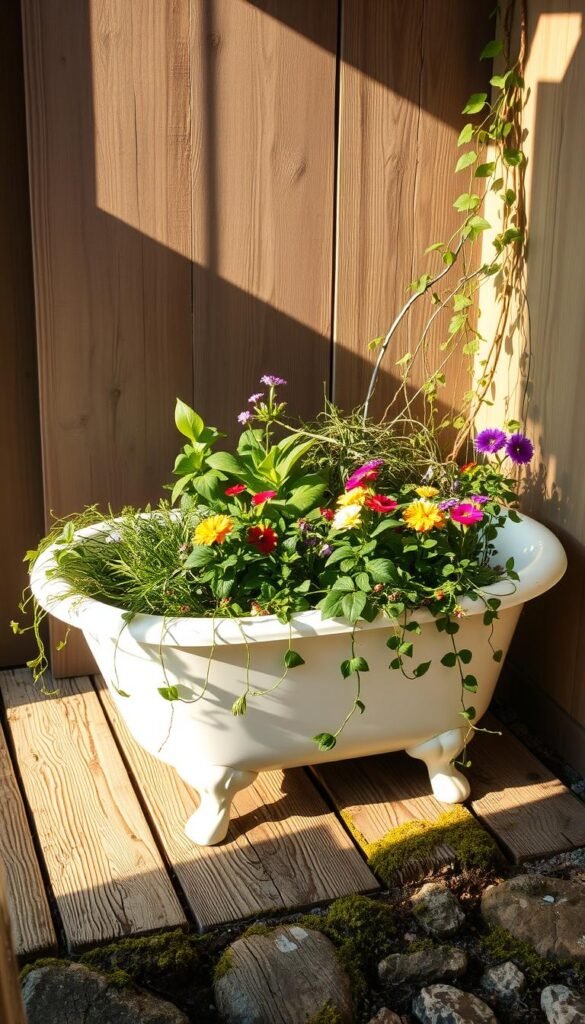
Your grandmother’s clawfoot tub might be the star of your outdoor space. Upcycling turns forgotten items into creative garden features that spark conversations. This approach blends sustainability with personality, letting you craft a one-of-a-kind landscape without big investments.
Repurpose Old Bathtubs and Vintage Finds into Unique Planters
Cast-iron tubs shine as instant garden planters—their depth supports root growth, while built-in drains prevent waterlogging. The Restore suggests:
“Drill 3-4 holes in the bottom if needed, then layer gravel and quality soil. A bathtub holds enough dirt for tomatoes, flowers, and trailing vines.”
Other thrifted treasures work too. Dresser drawers become cascading succulent displays. Wobbly chairs get new purpose as climbing rose supports. Even rusty wheelbarrows transform into mobile herb gardens.
Before planting, scrub items with vinegar solution and sand rough edges. Apply outdoor sealant to wooden pieces. This DIY approach reduces landfill waste while adding vintage charm. As The Restore’s tutorial shows, creativity matters more than perfection.
These projects let you design a space that reflects your story. Each weathered scratch becomes part of your garden’s character, proving sustainability and style grow beautifully together.
Elevate Your Garden with Raised Beds and Smart Soil Solutions
Transform your outdoor space using raised garden beds—a beginner-friendly solution that simplifies growing. Unlike traditional plots, these elevated setups improve drainage and reduce strain on your back. You’ll spend less time weeding and more time enjoying your plants.
Position your raised bed wherever sunlight shines brightest—patios, front yards, or backyards work equally well. Start with a 4×4-foot frame using cedar planks or recycled composite materials. These materials resist rot and fit most budgets.
Quality soil makes all the difference. Mix equal parts compost, peat moss, and vermiculite for nutrient-rich growth. This blend retains moisture while letting roots breathe. Designer Trapped recommends:
“Layer cardboard at the bed’s base to suppress weeds naturally. Refill with fresh mix each spring for optimal results.”
Maximize small spaces by planting vertically. Train cucumbers up trellises or grow lettuce beneath tomato plants. Rotate crops seasonally to keep your raised garden productive year-round. With smart planning, even compact beds yield surprising harvests.
12 Simple Garden Ideas for Beginners: Easy Projects to Start With
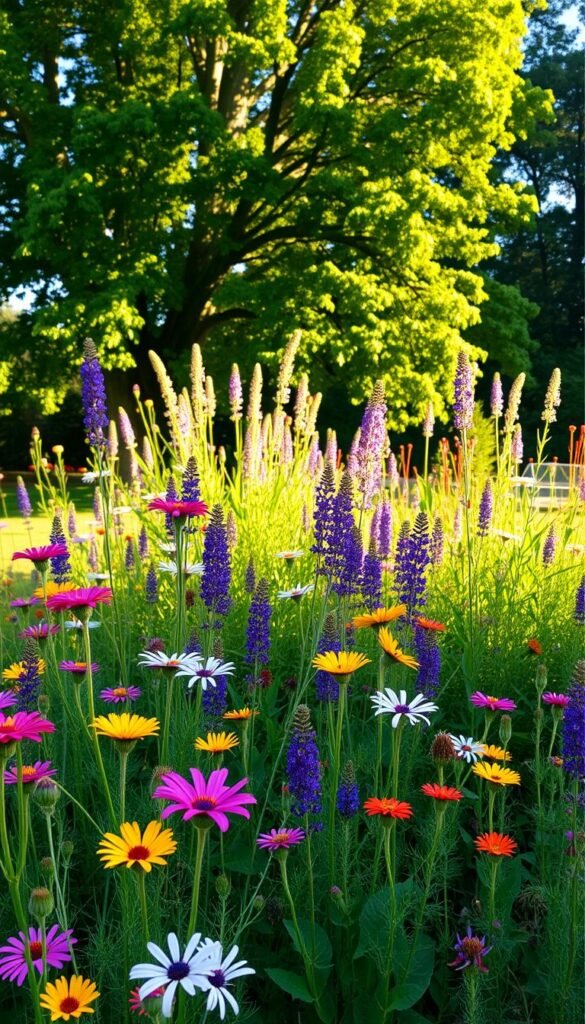
Tired of replanting flowers every spring? Perennial plants offer a smarter approach, returning with fresh blooms year after year. These hardy varieties establish deep roots over time, needing less care while creating reliable garden structure.
Seasoned growers follow the “walk, crawl, run” rule. Perennial flowers spend their first year settling in (walking), grow foliage in year two (crawling), and burst into full glory by season three (running). This patience pays off with plants that multiply naturally.
| Climate Zone | Plant Examples | Bloom Period |
|---|---|---|
| Cool (3-5) | Peonies, Daylilies | Late spring to summer |
| Temperate (6-8) | Coneflowers, Black-eyed Susans | Summer to fall |
| Warm (9-11) | Blanket Flowers, Salvia | Year-round blooms |
Space plants according to mature size—crowding stifles growth. Mix early bloomers like bleeding hearts with late-season stars like asters for continuous color. A Michigan State study found proper spacing reduces disease risk by 40%.
Prepare soil with compost before planting. Water deeply weekly during establishment, then let rainfall handle needs. Mulch around plants to retain moisture and suppress weeds. Over time, you’ll save money and effort while enjoying evolving garden drama.
“Perennials are the gift that keeps giving. Divide mature clumps every 3-4 years to refresh plants and share extras with friends.”
Illuminate Your Space with Hanging String Lights and Cozy Ambiance
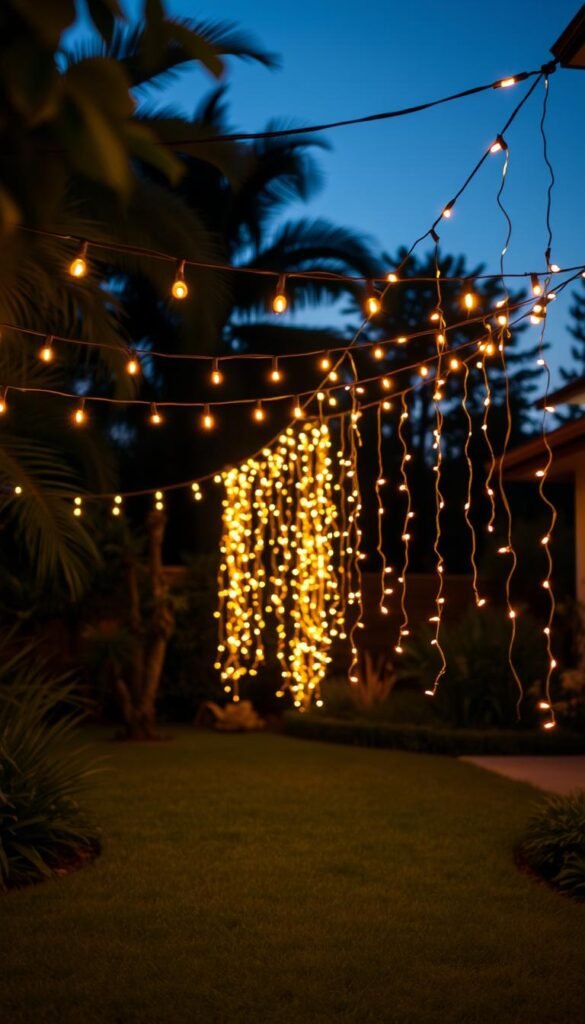
Turn your evenings into enchanting moments with hanging string lights that dance through your outdoor space. These twinkling wonders transform basic backyards into storybook settings, letting you enjoy fresh air long after sunset. Compact areas shine brightest—their confined nature amplifies the warm glow, creating intimate nooks perfect for quiet conversations.
Choose weather-resistant options designed for outdoor use. Solar-powered strands eliminate extension cords, while LED bulbs cut energy costs by 80% compared to traditional lights. Consider these popular styles:
| Type | Best For | Key Features |
|---|---|---|
| Solar Globe Lights | Eco-friendly setups | Automatic dusk-to-dawn operation |
| LED Café String | Permanent installations | Energy-efficient & dimmable |
| Edison Bulbs | Industrial chic spaces | Vintage aesthetic |
Drape strands between trees like botanical chandeliers. Outline your patio perimeter or zig-zag patterns over seating areas. For vertical interest, wrap trunks with copper wire lights—they’ll sparkle like fireflies in your backyard.
Lighting expert Clara Bennett advises:
“Use outdoor-rated hooks and measure twice before installing. A 20-foot strand comfortably covers 15 feet when hung loosely.”
Mix different bulb sizes for depth. Cluster lights above dining spots while keeping pathways subtly lit. With strategic placement, your space becomes a multi-functional retreat—perfect for morning coffee or midnight stargazing.
Welcome Wildlife: Bird Baths That Bring Life and Color
Your outdoor space becomes a living canvas when birds flutter to splash in a water feature. A shallow basin filled with fresh liquid transforms quiet corners into lively hubs, especially in compact yards where every detail matters. Observing sparrows bathe or robins sip creates daily moments of wonder while supporting local ecosystems.
Select Water Features That Attract Pollinators
Position your bird bath near flowering shrubs or perennials. The Honeycomb Butterfly Bush shines here—its golden blooms release honey-like scents that attract butterflies and hummingbirds. This hardy shrub survives frosts down to -20°F, offering structure through seasons.
Follow these care steps for thriving wildlife interactions:
- Refresh water every 2 days to prevent stagnation
- Scrub basins weekly with baking soda
- Add flat stones for insect drinking spots
Pair your bath with these pollinator magnets:
| Plant | Bloom Time | Visitors |
|---|---|---|
| Bee Balm | Summer | Hummingbirds |
| Coneflower | Fall | Butterflies |
| Lavender | Spring | Bees |
Master gardener Elena Carter notes:
“A clean water source surrounded by nectar-rich flowers triples pollinator activity. It’s nature’s perfect partnership.”
This combination creates self-sustaining habitats. You’ll enjoy vibrant colors and buzzing energy while giving birds and insects essential resources. Even small spaces can host this dynamic duo with smart plant choices.
Creating a Relaxing Retreat with a Classic Garden Bench
Picture yourself unwinding after a day’s work on a bench nestled among blooming flowers. These timeless pieces turn any backyard corner into a sanctuary where you can savor your gardening achievements. Strategically placed seating becomes a natural focal point, encouraging quiet reflection or lively chats with loved ones.
Choose materials that match your style and climate. Wood offers rustic charm but needs annual sealing, while powder-coated metal withstands harsh weather. For low-maintenance options, consider composite benches—they mimic natural textures without splinters or rust. Bench design inspiration shows how curved edges or slatted patterns enhance different spaces.
Position your seat where you’ll enjoy the best views—near flowering shrubs or under a shade tree. Morning light and afternoon shadows matter: east-facing spots catch sunrise glows, while west-facing areas stay cooler longer. Add potted geraniums or lavender on either side for color and fragrance that tie the space together.
Boost comfort with weather-resistant cushions in bold patterns. A small side table holds drinks or books, turning your bench into a functional retreat. Landscape designer Mara Holt suggests:
“Surround seating with soft ground covers like creeping thyme. Their texture feels delightful under bare feet and releases scent when brushed.”
Even simple upgrades make a difference. Hang string lights overhead for evening ambiance, or train jasmine vines along the backrest for natural privacy screens. Your backyard bench becomes more than furniture—it’s where memories grow alongside your plants.
Enhance Vertical Space with Arched Trellises and Lattice Walls
Turn unused vertical areas into lush growing zones with clever plant supports. Arched trellises instantly draw the eye upward, transforming blank walls or narrow pathways into living art. These structures let vines climb while freeing up ground space for other crops—perfect for patios or petite yards.
Incorporate Plant Supports for Optimal Sunlight
Pair climbing beans with cucumbers on opposite sides of a trellis. This strategic pairing maximizes vertical real estate while letting each plant thrive. Metal stakes keep stems upright, ensuring leaves soak up sunlight without shading neighbors.
Space seeds 12-18 inches apart to prevent overcrowding. Good airflow reduces mold risks and strengthens stalks. For inspiration, explore DIY trellis designs that blend function with rustic charm.
Keep plants elevated using lattice panels or willow arches. Off-the-ground growth protects fruits from pests and rot. Train tendrils gently with soft ties, adjusting every few days as shoots stretch skyward. Soon, you’ll harvest healthier crops while enjoying your garden’s new dimension.

